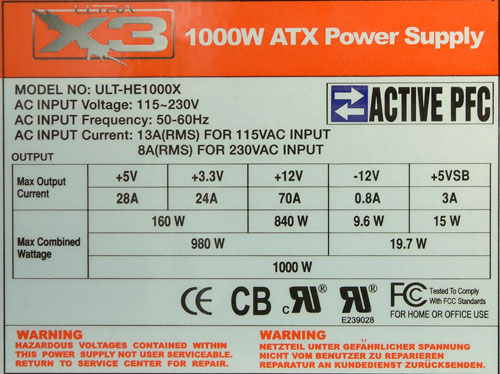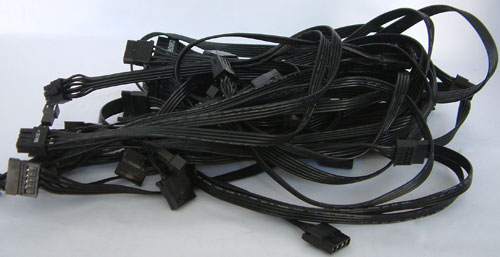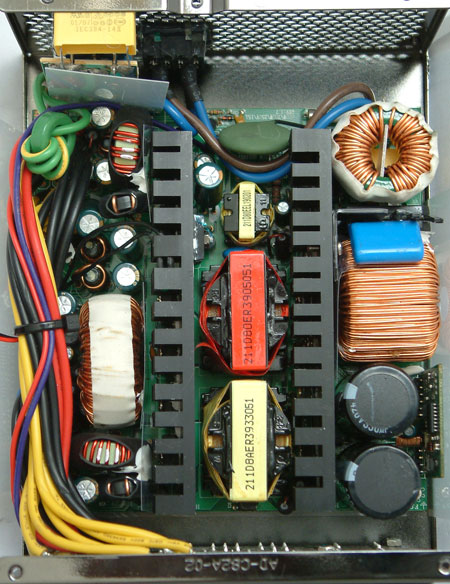Power Supply Roundup: Eight 1000W for the Extreme Users
by Christoph Katzer on December 11, 2007 9:30 PM EST- Posted in
- Cases/Cooling/PSUs
Ultra X3 1000W

The Ultra X3 is another older power supply; which is reason enough to include it in our roundup today. We can see if the newer models offer improved performance, or if they're merely newer. The X3 has a very nice mirror-finish coating and a large 135mm fan installed on the bottom. The back has plenty of perforations to serve as the exhaust. The packing is unusual in that the PSU is placed in the middle of the box between two massive sheets of foam, which makes it nearly impossible to damage the inside during transport. We are surprised more companies don't take this approach, particularly on expensive high-end models.

A single 12V rail is something we see on occasion, but this does not follow the latest PSU guidelines. The 12V rail provides up to 70A. The 3.3V rail has 24A and the 5V rail has 28A, which is enough for today's usage. This power supply is also rated with just 115 to 230VAC, but again we were able to test with 90VAC.

The cables are flat, with the wires running together similar to what we see with flat IDE cables. Ultra definitely has an eye-catching design with this approach, though the first company with these cables was Corsair. The length of the 24-pin, 4-pin, and 8-pin connector is only 40cm, which is really quite short. The X3 has four 6-pin and two 8-pin PEG connectors, though users can only connect four at the same time. The PEG lengths of 45 and 50cm is enough for medium size cases.

A look inside shows us two thick heatsinks without many fins on the sides. There is one large coil on the primary and two transformers in the middle. The caps in the secondary side are made by Teapo. Since the heatsinks don't have any large fins to the sides the air can travel nicely through even to the bottom of the PSU to cool each components attached to the PCB. The airflow is also very good since there aren't many obstacles in the way. Usually, however, larger heatsinks are used to provide a greater surface area and improved cooling performance; whether Ultra's approach will work as well as the more traditional designs remains to be seen.










29 Comments
View All Comments
brian_riendeau - Tuesday, December 18, 2007 - link
Depending on what site you check, I think you would find that very few 1000+ watt PSUs can sustain that output under load in real world conditions 100v to 120v. I am somewhat skeptical of that fact that 8 PSUs got tested here, and not a single one was labelled as a failure to provide on the rated specs.buzznut - Thursday, December 13, 2007 - link
So we have a line-up of 430 watt supplies, a comparison of 750-850 watt models, one of 1000 watts, and the "extreme" Power supplies at 1200W+.Anyone else notice the little gap there?
What about the 500-700 range, arguably the most popular with system builders right now? I can't even fathom why you would choose to ignore this segment.
Do ya think you could cover the more relevant enthusiest segment since this site is viewed by many enthusiests every day? I mean the ones that don't have $300 to blow on a power supply when a 650 watt one will do the job. Or ones that don't receive their equipment for free because they review hardware...
I buy a lot of equipment every year but I am not wealthy. I get tired of reviewers who tell me about the latest 700 dolla video card or other stuff I'll never be able to afford.
MadAd - Wednesday, December 12, 2007 - link
Nice touch adding in the Euro prices, a welcome change, infact a first in over 8 years of readership i think.Just a quick point, i think the import duty allowances on purchases abroad are very low, so flying to the US is fine for a holiday, but unless you are prepared to break the law and claim it as your pc you took out or something, then you would have to pay duty and vat as if youd had it shipped. Add to that any warranty claims may be null or awkward to service then it may not be the bargain it could be.
Christoph Katzer - Wednesday, December 12, 2007 - link
Wasn't really meant you would need to book a flight to go the States to buy a PSU... Of course there are import taxes (19-19,4% for France and Germany).PolymerTim - Wednesday, December 12, 2007 - link
Is there a power supply roundup coming out any time soon for something like 400W-700W. I've been reading through the PS forums lately and it seems like a lot of the recommended PS fall somewhere around the 450W-650W range and this seems to be missing from the roundups. I realize there were a lot of individual reviews in this range not too long ago, but there are several new options in this range in the last few months that I think deserve a review a bit more than yet another "ultra high" or "extreme" roundup. Just for illustration, I posted the date and title of every anandtech PS roundup since the new PS test methods came out 5 months ago. See the gap? We have 3 roundups between 730W-1300W and 1 roundup at 400W-450W.12-11 Power Supply Roundup: Eight 1000W for the Extreme Users
11-22 Power Supply Roundup: 730W to 900W
11-06 400-450W PSU Roundup
10-22 Ultra High-End PSU Roundup (1200W to 1300W)
Of course, many PS in this range were reviewed, but never in a roundup compared to other similar PS.
09-14 Seasonic S12II: 330W to 500W of Silence
09-11 Enermax Infiniti 650W
09-03 Zippy Serene (GP2-5600V)
08-27 Silver Power Blue Lightning 600W
08-08 Silverstone Decathlon DA650: A modular alternative
07-30 The Enermax Liberty - Getting long in the tooth, but still worth a look
07-24 Gigabyte's New Odin GT 800W Power Supply
07-18 PC Power & Cooling Silencer 750 Quad CF-Edition
07-13 The Single 12V Rail SilverStone Olympia OP650
Christoph Katzer - Wednesday, December 12, 2007 - link
Yeah this year still 600-650 watts...halcyon - Wednesday, December 12, 2007 - link
How about also another type of article:How to build a computer that does 90% of what people need (sans games) and runs on less than 30W?
800-1000W is insane and people should come around to understanding that.
strikeback03 - Wednesday, December 12, 2007 - link
I'm pretty sure even most laptops don't draw that little power. Not sure on the newer C2D processors, but I know the older Dothan Pentium M processors had a TDP in the 20-25W range. Add the rest of a system and you likely won't spend much time below 30W.Or check out some carputer setups. Using VIA mini-ITX motherboards with integrated processors and graphics and they still typically use 90-160W power supplies.
JarredWalton - Wednesday, December 12, 2007 - link
At idle, most of the moderate notebooks (14-15" chassis) sit at around 25W. Load, they'll get up to around 60W with IGP and 100W with something like an 8700M GT. 8800M GTX will probably push that closer to 125W (give or take 10W).jonnyGURU - Wednesday, December 12, 2007 - link
I'm game (no pun intended.)I built a machine with all on board components, a mobile AMD chip and solid state drives and it still required over 200W to run. Mind you it had a 7950 graphics card, but still.....